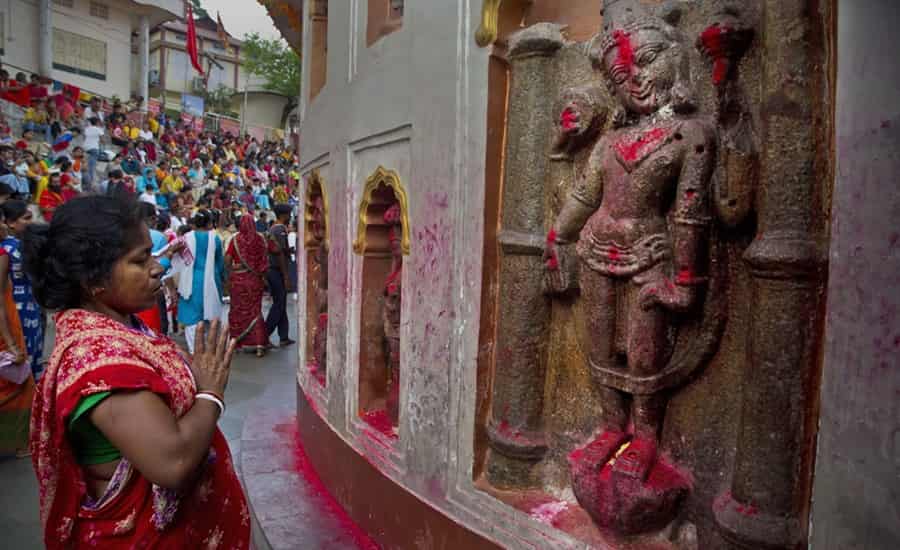Nestled atop the Nilachal Hill in Guwahati, Assam, the Kamakhya Temple stands as a timeless testimony to the rich tapestry of Indian culture, spirituality, and mythology. Steeped in history and veiled in mystique, this sacred shrine dedicated to Goddess Kamakhya is not just a physical structure but a living embodiment of the beliefs, rituals, and legends that have woven themselves into the fabric of Hinduism over millennia.

Historical Chronology
The origins of the Kamakhya Temple are shrouded in the mists of time, making it challenging to pinpoint its exact historical inception. However, archaeological evidence suggests that the temple has ancient roots, with the current structure dating back to the 17th century. The temple complex underwent renovations and expansions under various rulers, including the Koch and Ahom kings, who played pivotal roles in the cultural and religious landscape of Assam.
Mythology
The Legend of Sati
The mythology surrounding the Kamakhya Temple is intricately linked with the legend of Sati, the first wife of Lord Shiva. According to the myth, King Daksha organized a grand yajna (fire sacrifice) but intentionally excluded Shiva, Sati’s husband. Unable to bear the insult to her husband, Sati self-immolated in the sacrificial fire.
In his grief and rage, Shiva carried Sati’s charred body, engaging in the cosmic dance of destruction, known as the Tandava. To quell Shiva’s fury and prevent the impending apocalypse, Lord Vishnu intervened, and the divine Sudarshana Chakra severed Sati’s body into 51 pieces. These pieces, called Shakti Peethas, are believed to be scattered across the Indian subcontinent, each becoming a sacred site.
Kamakhya Temple is revered as the place where Sati’s yoni (female reproductive organ) fell, making it one of the most significant Shakti Peethas in Hindu tradition.
The Bleeding Goddess
One of the most intriguing aspects of Kamakhya Temple is the belief in the menstruation of the Goddess. According to local folklore, the stone image of the Goddess in the temple’s sanctum experiences menstrual flow annually during the Ambubachi Mela, a festival celebrated in June. Devotees believe that during these three days, the Earth’s creative energy is renewed, symbolizing the fertility aspect of the Goddess.
This unique ritual has sparked various interpretations, with some considering it a natural geological occurrence, while others view it as a profound representation of the divine feminine energy and the interconnectedness of the Earth’s cycles with the cosmic order.
Architectural Marvels
The Kamakhya Temple, with its distinct Assamese architecture, is a marvel of intricate design and spiritual symbolism. The main temple structure features a hemispherical dome with sculpted panels depicting various gods, goddesses, and mythological scenes. The shikhara (spire) crowning the temple adds to its grandeur, and the kalasha (urn) atop symbolizes purity and divinity.
The temple complex comprises several smaller shrines dedicated to different deities, contributing to its holistic spiritual ambiance. The natural surroundings of the Nilachal Hill enhance the temple’s sacred aura, creating a serene atmosphere conducive to meditation and worship.
Religious Practices and Pilgrimages
The Kamakhya Temple is a pilgrimage destination for devotees seeking blessings for fertility, prosperity, and spiritual awakening. The rituals performed at the temple follow a distinct Tantric tradition, emphasizing the worship of Shakti, the divine feminine energy. Devotees engage in practices such as yajnas, pujas, and meditation to invoke the Goddess’s blessings.
The Ambubachi Mela, celebrated annually during the monsoon, attracts pilgrims from far and wide. The festival coincides with the believed menstruation of the Goddess, and devotees consider this period highly auspicious for spiritual practices.
Legends and Folklore
Beyond the mainstream mythology, Kamakhya Temple is enshrined in local folklore and legends that have been passed down through generations. One such tale speaks of the temple’s connection to the powerful demon Narakasura. It is said that Kamakhya, with her divine prowess, vanquished Narakasura on the Nilachal Hill, liberating the region from his tyranny.
Another local legend narrates the story of the construction of the Kamakhya Temple by the demon Naraka, who sought redemption for his past sins. The temple, in this narrative, becomes a symbol of transformation and spiritual purification.
- Suggested Tour: Kamakhya Temple Tour Packages
Conclusion
The Kamakhya Temple stands not only as a physical edifice of religious significance but as a cultural treasure trove, echoing the diverse narratives that have shaped the religious landscape of India. Its ancient roots, entwined with the legend of Sati and the dynamic symbolism of the divine feminine, make it a pilgrimage site of profound spiritual importance.
As the Kamakhya Temple continues to draw pilgrims and seekers from various walks of life, its timeless allure persists, inviting exploration into the realms of history, mythology, and the mystical intersection of the earthly and the divine. Through its sacred rituals, architectural splendor, and enduring legends, the Kamakhya Temple remains an embodiment of the eternal dance between the tangible and the transcendent in the heart of Assam.
Also Read:

 Call
Call WhatsApp
WhatsApp Enquiry
Enquiry